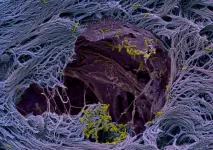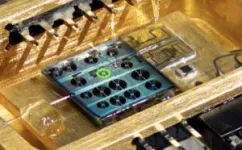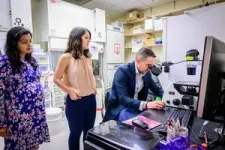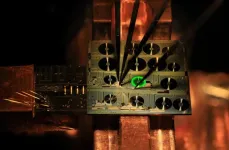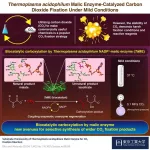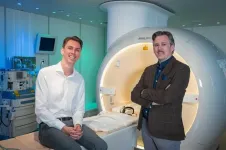(Press-News.org) How do pathogens invade the lungs? Using human lung microtissues, a team at the Biozentrum of the University of Basel has uncovered the strategy used by a dangerous pathogen. The bacterium targets specific lung cells and has developed a sophisticated strategy to break through the lungs’ line of defense.
Earlier this year, the WHO published a list of twelve of the world’s most dangerous bacterial pathogens that are resistant to multiple antibiotics and pose a grave threat to human health. This list includes Pseudomonas aeruginosa, a much-feared nosocomial pathogen that causes severe and life-threatening pneumonia. This pathogen is especially threatening to immunocompromised patients and those on mechanical ventilation, with mortality rates up to 50 percent.
The lung barrier is penetrable
Pseudomonas aeruginosa has developed a broad range of strategies to invade the lungs and the body. Researchers led by Prof. Urs Jenal at the Biozentrum, University of Basel, have now gained novel insights into the infection process using lab-grown lung microtissues generated from human stem cells. In the scientific journal “Nature Microbiology”, they describe how Pseudomonas breaches the top layer of lung tissue and invades deeper areas. This study was conducted as part of the National Center of Competence in Research (NCCR) “AntiResist”.
Our lungs are lined by a thin layer of tightly packed cells that protects the deeper layers of lung tissue. The surface is covered with mucus, which traps particles such as microorganisms and is removed from the airways by specialized cells. This layer serves as an effective almost impenetrable barrier against invading pathogens. However, Pseudomonas bacteria have found a way to breach it. But how the pathogen crosses the tissue barrier has remained a mystery until now.
Lung organoids provide new insight into infections in humans
“We have grown human lung microtissues that realistically mimic the infection process inside a patient’s body,” explains Jenal. “These lung models enabled us to uncover the pathogen’s infection strategy. It uses the mucus-producing goblet cells as Trojan horses to invade and cross the barrier tissue. By targeting the goblet cells, which make up only a small part of the lung mucosa, the bacteria can breach the defense line and open the gate.”
With a large arsenal of virulence factors, known as secretion systems, the pathogen specifically attacks and invades the goblet cells, replicates inside the cells and ultimately kills them. The burst of the dead cells leads to ruptures in the tissue layer, making the protective barrier leaky. The pathogens exploit this weak spot: They rapidly colonize the rupture sites and spread into deeper tissue regions.
New sensor for monitoring bacteria
Using human lung organoids, the scientists have been able to elucidate the sophisticated infection strategies of Pseudomonas. However, it remains unclear how the pathogens adapt their behavior during the infection process. For example, they must first be mobile to spread over the tissue surface, then quickly adhere to lung cells upon contact, and later activate their virulence factors. It is known that the bacteria can rapidly change their behavior thanks to small signaling molecules. Until now, however, the technology to study these correlations was not available.
Jenal’s team has now developed a biosensor to measure and track a small signaling molecule called c-di-GMP in individual bacteria. The method was recently described in Nature Communications. "This is a technological breakthrough," says Jenal. "Now we can monitor in real time and with high resolution how this signaling molecule is regulated during infection and how it controls the pathogen’s virulence. We now have a detailed view on when and where individual bacterial cells activate certain programs to regulate their behavior. This method enables us to investigate lung infections in more detail."
Organ models mimic conditions in patients
"Thanks to the development of human lung organoids, we now have a much better understanding of how the pathogens behave in human tissue and presumably in patients," emphasizes Jenal. "This brings us a big step closer to the goal of NCCR AntiResist." Organoids of the human lung and other organs like the bladder allow the researchers to study the effects of antibiotics in tissue, for example, identifying where and how bacteria survive during treatment. Such organ models will be indispensable in the future for developing new and effective strategies to combat pathogens.
END
Lung organoids unveil secret: How pathogens infect human lung tissue
2024-06-10
ELSE PRESS RELEASES FROM THIS DATE:
The solar system may have passed through dense interstellar clouds 2 million years ago, altering Earth’s climate
2024-06-10
Around two million years ago, Earth was a very different place, with our early human ancestors living alongside saber-toothed tigers, mastodons, and enormous rodents. And, depending on where they were, they may have been cold: Earth had fallen into a deep freeze, with multiple ice ages coming and going until about 12,000 years ago. Scientists theorize that ice ages occur for a number of reasons, including the planet’s tilt and rotation, shifting plate tectonics, volcanic eruptions, and carbon dioxide levels in the atmosphere. ...
Miniaturizing a laser on a photonic chip
2024-06-10
Lasers have revolutionized the world since the 60’s and are now indispensable in modern applications, from cutting-edge surgery and precise manufacturing to data transmission across optical fibers.
But as the need for laser-based applications grows, so do challenges. For example, there is a growing market for fiber lasers, which are currently used in industrial cutting, welding, and marking applications.
Fiber lasers use an optical fiber doped with rare-earth elements (erbium, ytterbium, neodymium etc) as their optical gain source (the part that produces the laser’s light). They emit high-quality beams, they have high power output, and they are efficient, ...
Study: Physical activity in the evening lowers blood sugar levels
2024-06-10
ROCKVILLE, Md.— New research reveals that moderate to vigorous physical activity in the evening for sedentary adults with overweight and obesity is most beneficial in lowering daily blood sugar levels, according to a study published in Obesity, The Obesity Society’s (TOS) flagship journal.
Experts explain that it has been well established that moderate to vigorous physical activity enhances glucose homeostasis in adults with overweight and obesity who are at higher risk of developing insulin resistance. ...
Experts develop nutritional recommendations for patients treated with anti-obesity medications
2024-06-10
ROCKVILLE, Md.— Individuals treated with anti-obesity medications generally experience reduced appetite, which typically leads to reduced food intake. As a result, dietary quality becomes more important because nutritional needs must be met within the context of eating less. To improve this process, medical experts have developed a list of evidence-based nutritional recommendations to assist clinicians treating patients with anti-obesity medications, according to a review published in the journal Obesity, The Obesity Society’s (TOS) flagship journal.
“Our evidence-based review aims to equip clinicians with knowledge ...
Peers crucial in shaping boys’ confidence in math skills
2024-06-10
Boys are good at math, girls not so much? A study from the University of Zurich has analyzed the social mechanisms that contribute to the gender gap in math confidence. While peer comparisons seem to play a crucial role for boys, girls’ subjective evaluations are more likely to be based on objective performance.
Research has shown that in Western societies, the average secondary school girl has less confidence in her mathematical abilities than the average boy of the same age. At the same time, no significant difference ...
Fixing excess carbon dioxide: biocatalyst-driven carboxylation under mild conditions
2024-06-10
Carbon capture and utilization technologies for the conversion of carbon dioxide into carboxylic acids have garnered attention recently, with researchers from Tokyo Tech recently demonstrating a biocatalyzed carboxylation reaction of not only natural substrate, pyruvate, but also unnatural one, 2-ketoglutarate, using Thermoplasma acidophilum NADP+- malic enzyme under mild reaction conditions. The proposed strategy can be tailored for the selective synthesis through carbon dioxide fixation reactions.
Removing the excess carbon dioxide (CO2) from the environment is not the end goal of the decarbonization process necessary to ...
Lung cancer screening prolongs lives in real-world study
2024-06-10
Among US veterans diagnosed with lung cancer through the Veterans Health Administration healthcare system, those who underwent screening before diagnosis were more likely to be diagnosed with earlier stage disease and had a higher cure rate than those who had not been screened. The findings come from an observational study published by Wiley online in CANCER, a peer-reviewed journal of the American Cancer Society.
Lung cancer is the leading cause of cancer deaths worldwide, and most patients are diagnosed at ...
New study reveals links between social anxiety, depression and suicidal thoughts in adolescents
2024-06-10
Peer-reviewed – Observational study - People
Adolescents who experience higher levels of social anxiety symptoms are more likely to report increased suicidal thoughts and other depressive symptoms two years later, according to new research.
The University of East Anglia-led study sheds light on the pressing need for early interventions to address society anxiety in young people.
Lead author Dr Kenny Chiu, Clinical Lecturer in Clinical Psychology at UEA’s Department of Clinical Psychology and Psychological Therapies, said: “Social Anxiety Disorder ...
Disturbed blood flow can damage the vessel wall in cases of aortic dilation
2024-06-10
Abnormal blood flow in the aorta is linked to inflammation and breakdown of the vessel wall in conditions where the aorta is dilated. This is shown in a study led by researchers at Linköping University. The findings can contribute to better diagnosis and open up new ways to assess the risk of serious and usually fatal complications, such as rupture of the aorta.
All blood in the body passes through the heart about once a minute. With every heartbeat, blood from the heart is pumped up into the aorta.
Dilation can occur in all parts ...
Psychosocial skills can stop relapse in people with eating disorders, says expert
2024-06-10
Health services should teach patients with eating disorders psychosocial skills to help more people recover and avoid relapse, according to an expert.
Anorexia, bulimia and other eating issues affect millions of people, and eating disorder specialist Bethany Crowley warns that eating disorders are often misunderstood. She suggests a more integrated approach to treating people is needed, to focus on the whole person rather than just the disordered eating.
Quieting negative thoughts, learning to cope with emotional triggers and practicing self-compassion are among nine key skills outlined by the therapist in a new book.
An Integrative Approach to Treating Eating ...
